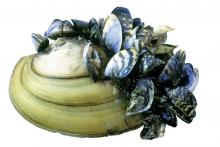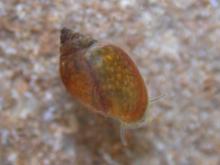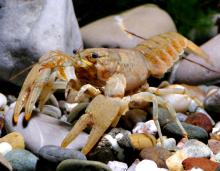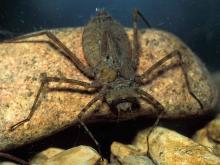Aquatic Invertebrates
Media

Species Types
Scientific Name
Dreissena polymorpha
Description
Zebra mussels are named for their shells, which have alternating light and dark bands. They are a highly invasive nonnative species. Learn how to prevent their spread.
Media

Species Types
Scientific Name
Over 20 Missouri species in former subclass Prosobranchia
Description
Gilled snails are one of two main groups of aquatic snails in Missouri (the other group is the "lunged" snails). Gilled snails, or prosobranchs, breathe with gills and possess a hard trapdoor-like operculum. They are most common in the Ozarks.
Media

Species Types
Scientific Name
Over 30 Missouri species in former subclass Pulmonata
Description
Pulmonate, or lunged snails breathe via a lunglike pulmonary cavity, and they lack the hard trapdoor-like operculum found in gilled snails. Except for in the Ozarks, pulmonate snails predominate in most of the aquatic regions in our state.
Media

Species Types
Scientific Name
Gyraulus, Helisoma, Menetus, Micromenetus, Planorbula spp.
Description
Ramshorn snails are easy to identify at a glance, because the shell is a flat, disklike coil. Like other pulmonate aquatic snails, they lack the hard horny “trapdoor” possessed by other types of aquatic snails.
Media

Species Types
Scientific Name
Faxonius macrus (formerly Orconectes macrus)
Description
The Neosho midget crayfish is a subdued mottled brown, with a prominent black band crossing the carapace near its junction with the abdomen. The pincers are broad and powerful. This small, stout crayfish is found in the Neosho stream drainage of southwestern Missouri and northwestern Arkansas.
Media

Species Types
Scientific Name
Palaemonetes kadiakensis
Description
Of Missouri’s two species of freshwater shrimp, the Mississippi grass shrimp is by far the most common and widespread.
Media

Species Types
Scientific Name
Faxonius williamsi (formerly Orconectes williamsi)
Description
Williams' crayfish is small and rather plain, without bright colors or bold markings. It has a pale, vase-shaped zone along the middle of the dark olive-tan carapace. It is found only in the upper White River drainage of Missouri and Arkansas.
Media

Species Types
Scientific Name
Species in the suborder Anisoptera
Description
Dragonfly larvae are aquatic insects with large eyes, six legs, and an oval or rounded segmented abdomen. The lower jaws are scooplike and cover much of the lower part of the head.
Species Types
Scientific Name
Various species in the genus Hydra
Description
We’ve all seen aquariums and pictures of tropical saltwater invertebrates such as corals, jellyfish and anemones—but did you know that there are similar creatures living in the freshwater habitats of Missouri?
Media

Species Types
Scientific Name
Various species in the subclass Hirudinea
Description
Most people are repulsed by leeches. But once you get past the fact that many species are parasitic bloodsuckers, you will discover that they are fascinating creatures with an important role in nature.
See Also
About Aquatic Invertebrates in Missouri
Missouri's streams, lakes, and other aquatic habitats hold thousands of kinds of invertebrates — worms, freshwater mussels, snails, crayfish, insects, and other animals without backbones. These creatures are vital links in the aquatic food chain, and their presence and numbers tell us a lot about water quality.





















